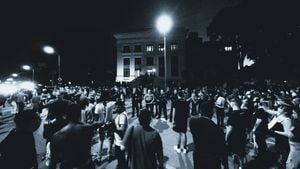Ongoing sectarian violence in the Kurram district of Khyber Pakhtunkhwa, Pakistan, has spiraled out of control, leading to tragic losses of life and injury. Recent clashes between Sunni and Shia armed groups have claimed at least 37 lives and left 25 injured, according to reports from various news outlets.
The violence erupted after armed confrontations broke out overnight, with gunmen using heavy weaponry on both sides, resulting in widespread destruction. Local police confirmed the clashes mainly involved the Alizai and Bagan tribes and were intensified by longstanding tensions stemming from recent land disputes. Witnesses described brutal ambushes, where gunmen targeted civilian vehicles indiscriminately. Shockingly, no group claimed responsibility for the attacks, raising alarms about the possible targeted aggression against the Shia community amid this climate of sectarian strife.
Survivors recounted horrific scenes of violence, with reports of gunmen attacking passenger vehicles without mercy. The situation has created chaos, prompting local authorities to shut down educational institutions as safety concerns mount. This latest wave of violence has drawn parallels to previous incidents, including one where 42 individuals lost their lives, leading to fears of systematic targeting of the Shia population.
To counter the rising tide of violence, Pakistani officials have intervened and announced a seven-day ceasefire between the warring sectarian groups. This move follows recent clashes, which began after gunmen attacked civilian convoys, resulting in the deaths of primarily Shia Muslims. Following public outrage and advocacy for peace, Muhammad Ali Saif, spokesperson for the Khyber Pakhtunkhwa provincial government, confirmed the ceasefire and mentioned provisions for prisoner exchanges and the return of bodies to families.
This decision marks a hopeful step toward addressing entrenched issues; nonetheless, sectarian rivalry has plagued the region for decades. The Kurram district has been particularly affected by tensions between Sunni and Shia groups, especially over long-standing land disputes. Historical grievances have often been amplified by external influences and local power dynamics.
After the ceasefire was announced, Akhtar Hayat Gandpur, the police chief of Khyber Pakhtunkhwa, acknowledged the firm call for accountability among the Shia community, which demands swift justice for those who perpetrated the attacks on civilians. The province’s Law Minister Aftab Alam Afridi emphasized the urgency of addressing the underlying grievances of both communities, hoping to broker lasting peace.
This recent violence is not isolated, as incidents over recent months reflect the fragile situation. Just last month, at least 16 deaths were recorded, including innocent women and children, due to similar sectarian confrontations. The Human Rights Commission of Pakistan documented at least 79 fatalities tied to sectarian violence since July, highlighting the alarming trend of rising casualties.
Despite local authorities’ efforts, including attempts to restore order through tribal councils, controlling the violence has proven to be challenging. The Kurram district was integrated with Khyber Pakhtunkhwa province only a few years back, and this transition has not alleviated the systemic sectarian strife present.
The unrest has sparked widespread protests, with hundreds taking to the streets of major cities such as Karachi and Lahore, condemning the violence and calling for swift government action to prevent future attacks. This alarming pattern has wrapped the district in fear, silence, and mourning as families grapple with the loss of their loved ones.
This latest episode of violence encapsulates the deep-rooted issues affecting sectarian communities across Pakistan. With tensions running high and no clear resolution on the horizon, authorities must prioritize dialogue, reconciliation, and accountability to forge peace and prevent another tragic loss of life.



